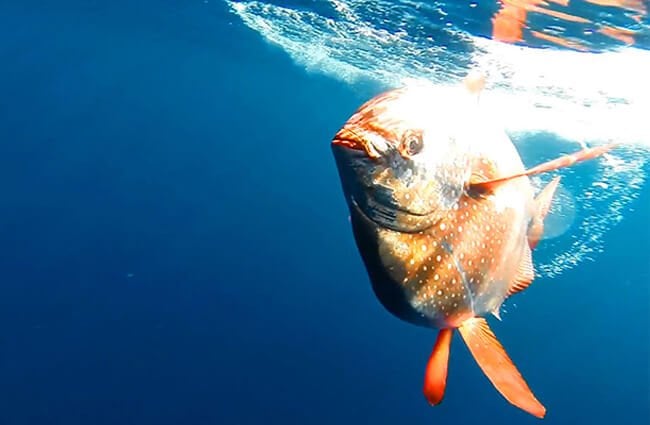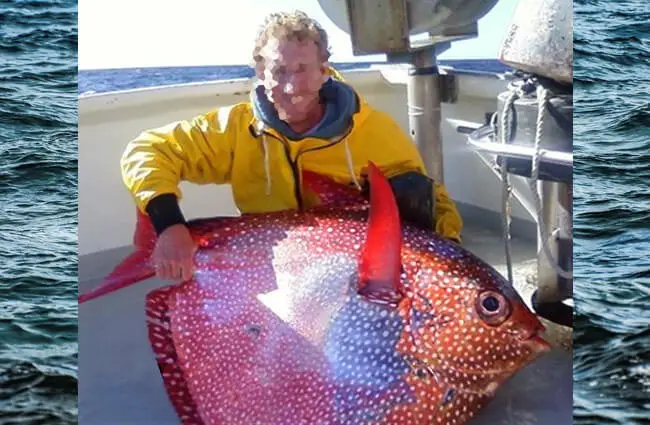The ocean depths hold countless mysteries, and among the most captivating is a creature often described as a living jewel: the Moon Fish. With its striking appearance and unique biological adaptations, this deep-sea marvel has captured the imagination of marine biologists and ocean enthusiasts alike. Join us on a journey to uncover the secrets of this enigmatic inhabitant of the global seas, from its shimmering scales to its warm heart.
Unveiling the Moon Fish: A Glimpse into its World
The term “Moon Fish” most commonly refers to the Opah, scientifically known as Lampris guttatus. This magnificent fish is instantly recognizable by its large, disc-shaped body, often adorned with a vibrant silvery-blue hue and distinct white spots, giving it an almost celestial appearance. Its fins, particularly the pectoral and caudal fins, are often a striking vermillion, adding to its allure. Growing to impressive sizes, some specimens can reach over two meters in length and weigh hundreds of kilograms, making them a truly substantial presence in the marine environment.
![Moon fish caught in Naples, Italy Photo by: [public domain]](https://animals.net/wp-content/uploads/2020/01/Moon-Fish-2-650x425.jpg)
Where the Moon Fish Dwells: Habitat and Distribution
Moon Fish are primarily pelagic, meaning they inhabit the open ocean, far from the coast or seabed. Their distribution is remarkably widespread, found in temperate and tropical waters across the globe, including the Atlantic, Pacific, and Indian Oceans. While often associated with the deep sea, they are known to occupy a broad vertical range, from near the surface down to depths exceeding 500 meters. They prefer waters with moderate temperatures, often congregating in areas where nutrient-rich upwellings support a diverse food web. Aspiring zoologists and animal lovers hoping to spot a Moon Fish in its natural habitat would need to venture into these vast oceanic expanses, typically through deep-sea fishing expeditions or specialized submersible observations, as they are not commonly found in coastal shallows.
![A beautiful photo of a Moon Fish under water Photo by: Ralph Pace, NOAA [public domain]](https://animals.net/wp-content/uploads/2020/01/Moon-Fish-3-650x425.jpg)
The Moon Fish Menu: A Deep Dive into Diet
As active predators of the open ocean, Moon Fish possess a varied and opportunistic diet. Their large mouths and powerful jaws are well-suited for capturing a range of prey. Primary food sources include various species of squid, which they likely pursue using their keen eyesight in the dim light of deeper waters. They also consume a significant amount of krill, small crustaceans that form the base of many oceanic food webs. Additionally, smaller fish species contribute to their diet, demonstrating their adaptability as generalist feeders. This diverse diet highlights their crucial role in the marine ecosystem, transferring energy from lower trophic levels to higher ones.
Evolutionary Marvel: The Warm-Blooded Wonder
Perhaps one of the most astonishing discoveries about the Moon Fish is its unique physiology: it is the only known fully warm-blooded fish. Unlike most fish, which are ectothermic or “cold-blooded” and rely on external temperatures to regulate their body heat, the Moon Fish maintains a consistently elevated body temperature, particularly in its core organs and muscles. This remarkable adaptation, known as regional endothermy, is achieved through a specialized network of blood vessels called a “rete mirabile” in its gills. This countercurrent heat exchange system allows it to retain metabolic heat, keeping its brain, eyes, and swimming muscles warmer than the surrounding cold ocean water. This evolutionary advantage grants the Moon Fish superior swimming performance, faster reaction times, and enhanced visual acuity in the frigid depths, giving it a significant edge over its cold-blooded prey and competitors.

Life’s Journey: Mating and Reproduction
The reproductive strategies of the Moon Fish, like many deep-sea species, are not fully understood due to the challenges of observing them in their natural environment. However, what is known suggests they are broadcast spawners. This means that during the mating season, females release vast quantities of eggs into the water column, which are then externally fertilized by sperm released by the males. The eggs are pelagic, drifting with ocean currents as they develop. This strategy, common among many marine fish, maximizes the dispersal of offspring and increases the chances of survival in the vast ocean. Moon Fish are believed to reach sexual maturity at a relatively large size, and their lifespan can extend for several years, allowing them multiple reproductive cycles throughout their lives.
An Ecosystem Contributor: Interactions and Impact
In the intricate tapestry of the marine ecosystem, the Moon Fish plays a significant role. As a mid-to-top-level predator, it helps regulate populations of squid, krill, and smaller fish, contributing to the overall health and balance of its habitat. Its large size and nutritional value also make it a potential food source for larger oceanic predators, though specific predator-prey relationships are still being studied. The Moon Fish’s unique warm-bloodedness also impacts its ecological niche, allowing it to exploit a wider range of temperatures and depths than many other fish, thus influencing energy flow across different oceanic layers.
Moon Fish and Humanity: Culture, Commerce, and Conservation
The Moon Fish has a multifaceted relationship with human culture and industry. Its striking appearance has made it a subject of fascination, occasionally appearing in marine art and folklore. More significantly, it is a commercially valuable fish, particularly in certain regions. Its firm, rich flesh is highly prized in culinary circles, often compared to tuna or swordfish, and is a popular choice for sashimi and other gourmet preparations. This demand has led to its capture by commercial fisheries, primarily as bycatch in tuna and swordfish longline operations, but also through targeted fishing in some areas.
![Fisherman showing off his large catch – a Moon Fish Photo by: Unknown (NOAA Fisheries) [Public domain]](https://animals.net/wp-content/uploads/2020/01/Moon-Fish-1-650x425.jpg)
Conservation Status and Management
Despite its commercial value, the Moon Fish’s conservation status is generally considered stable, with populations not currently listed as endangered or vulnerable by major conservation organizations. However, due to its deep-sea habitat and pelagic nature, comprehensive population assessments are challenging. Sustainable fishing practices and ongoing research are crucial to ensure that Moon Fish populations remain healthy for future generations. Monitoring bycatch rates and understanding their reproductive cycles are key aspects of responsible management.
Practical Insights for Enthusiasts and Professionals
Encountering a Moon Fish in the Wild
For the animal lover aiming to find a Moon Fish in the wild, direct encounters are rare and typically limited to specific circumstances. These are not fish one encounters while snorkeling near a coral reef. Instead, finding one usually involves:
- Deep-Sea Fishing: Anglers targeting tuna or swordfish in open ocean environments may occasionally catch a Moon Fish.
- Scientific Expeditions: Participation in marine research voyages that utilize deep-sea submersibles or specialized trawling nets might offer a glimpse.
- Beach Strandings: Very rarely, a sick or disoriented Moon Fish might wash ashore, offering a unique but unfortunate opportunity for observation.
If a diver or angler encounters a Moon Fish, it is generally a docile creature and poses no threat. Observing from a respectful distance is always recommended. For hikers, an encounter with a live Moon Fish in the wild is virtually impossible, as they are exclusively marine animals. Any sighting on land would indicate a stranded specimen, in which case local marine wildlife authorities should be contacted immediately.
Caring for Moon Fish in Captivity: A Zookeeper’s Guide
Keeping Moon Fish in captivity is an exceptionally challenging endeavor, primarily due to their deep-sea pelagic nature and specific physiological requirements. For a zookeeper tasked with such a rare opportunity, the following considerations are paramount:
- Tank Size and Design: Requires an immense, deep, and circular or oval tank to accommodate their large size and continuous swimming patterns, preventing collisions with walls.
- Water Parameters: Maintaining stable, cool water temperatures (mimicking their natural deep-sea environment) is critical. Precise control over salinity, pH, and dissolved oxygen levels is also essential.
- Diet: A diverse diet of high-quality, appropriately sized squid, krill, and small fish, provided regularly to meet their high metabolic demands.
- Environmental Enrichment: While challenging for pelagic fish, ensuring ample swimming space and a calm environment is key. Avoid sudden changes in lighting or water flow.
- Health Monitoring: Regular observation for signs of stress, injury, or disease. Given their rarity in captivity, veterinary expertise in deep-sea fish physiology is crucial.
- Avoid:
- Small or rectangular tanks that restrict movement and cause stress.
- Rapid changes in water temperature or chemistry.
- Overcrowding with other species that may compete or cause aggression.
- Loud noises or vibrations that can disturb sensitive deep-sea inhabitants.

Fascinating Facts About the Moon Fish
Here is a list of intriguing facts that highlight the Moon Fish’s unique place in the marine world:
- Only Fully Warm-Blooded Fish: It is the sole known fish species capable of maintaining its entire body at a temperature warmer than the surrounding water.
- Celestial Appearance: Its round body, silvery sheen, and white spots evoke images of the moon, hence its common name.
- Deep-Sea Explorer: Capable of diving to depths of over 500 meters, navigating the twilight zone of the ocean.
- Global Traveler: Found in temperate and tropical waters across all major oceans.
- Speed and Agility: Its warm muscles provide an advantage for faster swimming and more agile hunting in cold waters.
- Culinary Delicacy: Highly prized for its rich, flavorful meat, especially in sushi and sashimi preparations.
- Large Size: Can grow to impressive dimensions, with some individuals exceeding two meters in length.
- Solitary Nature: Generally observed as solitary individuals, though more research is needed on their social behaviors.
- Unique Gills: Possesses a specialized blood vessel network in its gills, the rete mirabile, essential for its warm-bloodedness.
- Opportunistic Predator: Feeds on a diverse diet of squid, krill, and small fish.
Conclusion: A Shimmering Icon of the Deep
The Moon Fish, or Opah, stands as a testament to the incredible diversity and adaptability of life in our oceans. From its striking appearance and global distribution to its groundbreaking warm-blooded physiology, every aspect of this creature invites wonder and further study. It reminds us that even in the most explored corners of our planet, profound biological marvels await discovery. Understanding and appreciating the Moon Fish not only enriches our knowledge of marine life but also underscores the importance of ocean conservation, ensuring that these shimmering icons of the deep continue to thrive for generations to come.

![Red Angus Closeup of a beautiful Red Angus cowPhoto by: U.S. Department of Agriculture [pubic domain]https://creativecommons.org/licenses/by/2.0/](https://animals.net/wp-content/uploads/2020/03/Red-Angus-4-238x178.jpg)




![Red Angus Closeup of a beautiful Red Angus cowPhoto by: U.S. Department of Agriculture [pubic domain]https://creativecommons.org/licenses/by/2.0/](https://animals.net/wp-content/uploads/2020/03/Red-Angus-4-100x75.jpg)

